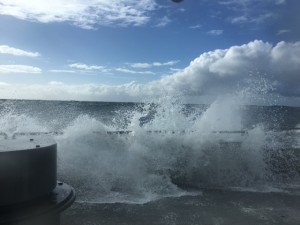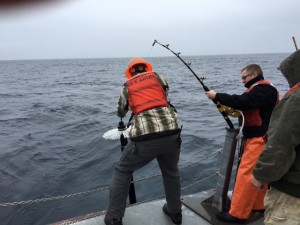15 March 2016
A rough ride down the Oregon coast
Posted by larryohanlon
by Nanci Bompey
Nanci Bompey is AGU’s public information manager. She is spending a week aboard the R/V Oceanus with scientists from Oregon State University who are studying the role that small rivers play in the productivity of the coastal ocean during the winter. Click here to read Nanci’s previous blogs from this trip.
When you plan a research cruise in the winter in Oregon, there’s a good chance the weather will change your plans. That’s what happened to us this weekend.
We were finally able to get back out on the ocean on Monday afternoon and we drove south to the Umpqua Hydrographic line – a seven-hour trip. It was a rough ride and most people spent it in their bunks or in the lounge, where books flew off the shelves when we hit particularly rough spots.
The combined wave height, or the height of the swell plus the wind waves, was about 20-feet. At points, the ship was at about a 20-degree angle, according to members of the ships’ crew. We were also traveling in the trough, so waves were pounding against the side of the boat.
It was a relief to finally reach the first sampling station where operations resumed again on Monday night.
In addition to Goni’s team, which is studying the nutrients in the water, there are two other groups aboard the R/V Oceanus. Kipp Shearman, a physical oceanographer at OSU, is looking at the mixing process between the freshwater coming from the rivers and the coastal ocean water.
Shearman and his team have been deploying an instrument called a Vertical Microstructure Profiler, or VMP, to examine this mixing process on a very fine scale. They are also using an acoustic velocity sensor mounted on the CTD to measure small scale velocity changes in the water that can also tell them about the mixing that is going on.
This information about the mixing process can help scientists figure out where the material and nutrients from the river are going in the ocean. It also allows them to tell if the freshwater coming from the rivers forms a lens of less-dense water on top of the salty ocean water. The researchers think that this lens allows phytoplankton to be at the surface, where there is enough light to photosynthesize. Without the upwelling of water that occurs in the summer, this freshwater lens could be helping to drive phytoplankton growth, and productivity, during the winter.





 GeoSpace is a blog on Earth and space science, managed by AGU’s Public Information staff. The blog features posts by AGU writers and guest contributors on all sorts of relevant science topics, but with a focus on new research and geo and space sciences-related stories that are currently in the news.
GeoSpace is a blog on Earth and space science, managed by AGU’s Public Information staff. The blog features posts by AGU writers and guest contributors on all sorts of relevant science topics, but with a focus on new research and geo and space sciences-related stories that are currently in the news.